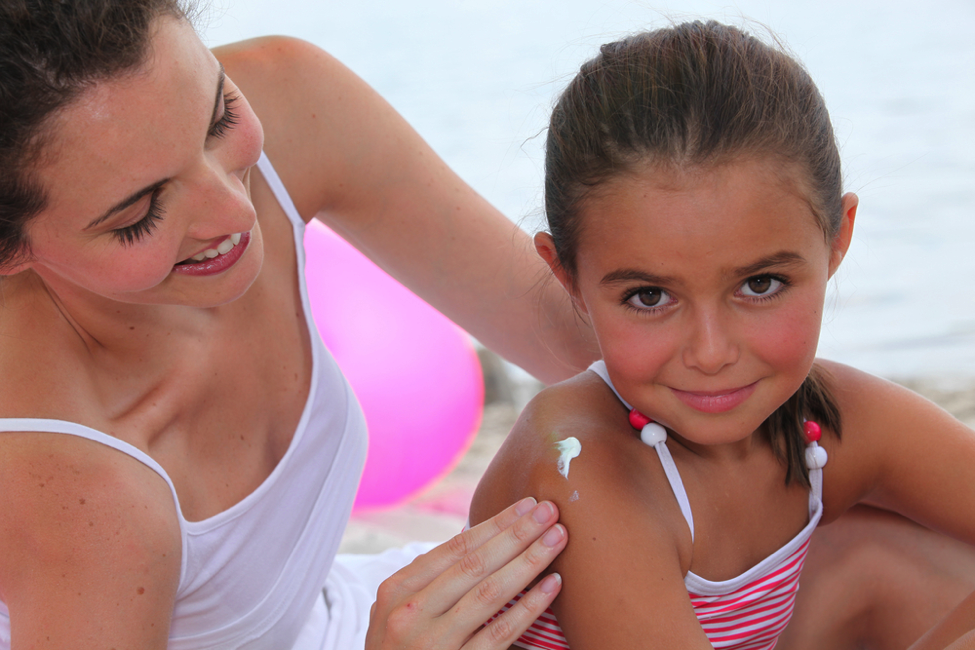Summertime is here and that means hours outside and fun in the sun. Unfortunately, along with days spent by the pool and playing in the sand that means our children are at elevated risks for experiencing sun burn, rashes, bug bites, dry skin, and more. This makes it essential that we take measures to protect our kids’ skin to keep them healthy and prevent their summers from turning into bummers. To help us on this journey, we have created the following skin protection guide for children this season.

10 Essential Tips for Protecting a Child’s Skin
Remember the sunscreen. Unfortunately, a child’s risk of developing melanoma, the deadliest form of skin cancer, in their lifetime will double if a child receives just one sunburn that blisters as a child. One! We need to make sure we are protecting their young sensitive skin with adequate sunblock. Experts recommend reapplying sunblock with an SPF ranging between 30 and 50 every two hours for the ultimate protection.
Before trying new sunscreens or skin products do a small skin test first. A terrible story about a child reacting to her sunscreen has been making the rounds on social media. We would feel awful if we applied a large amount of cream to a child and they broke out in blisters or a rash. This cautionary tale is a good reminder that everyone should do a simple spot test overnight on an arm or wrist to make sure there are no reactions to a new product.
Drink plenty of water. Keep skin hydrated and healthy by consuming adequate amounts of water. In addition, kids will avoid dehydration and will feel better during the summer activities they love to participate in.
Avoid playing outside during the hottest part of the day and at dusk. Avoiding peak sun and bug activity can protect our little one’s largest organ, their skin from sun burns, heat rashes, and unnecessary mosquito bites.
Limit baths. Surprisingly, we might be overbathing our children. Frequent baths and favorite soaps can cause dry skin, irritation, and rashes. According to The American Academy of Dermatology, children between the ages of 6 and 11 should bathe about once or twice a week. They do add that kids who have been playing in the dirt, gone swimming, or have body odor can take an extra shower as needed. This is great news for busy parents who might have missed one or two bath nights over the years.
Take measures to protect children from bugs. Bites and stings are uncomfortable, but they can also expose our kids to dangerous side effects like allergic reactions, Lyme Disease, West Nile Virus, and more. When outside we should dress our kids in long pants or shirts to reduce exposure to ticks and use bug repellents to prevent mosquito bites. As an added precaution, encourage children to always wear shoes outdoors to prevent stepping on bees, ants, or other critters.
Invest in protective UV clothing, sunglasses, and hats. Take advantage of today’s technology and dress children to reflect the damaging rays of the sun. Often these clothes are lightweight and ideal for sunny days at the pool or beach.
Moisturize and hydrate their skin. Heat, chlorine, and irritating allergens can wreak havoc on our children’s skin. Help them feel comfortable by using lotions or essential oils to treat common skin conditions.
During the hottest months, make sure to use fabric that breathes. Look for natural, lightweight clothing that prevents overheating or sweating. Children need to be comfortable and able to sweat without fear of heat rashes. Good Housekeeping recommends cotton and linen as a couple of good choices.
Keep babies and toddlers out of the sun. Many sunscreens are not suitable for our youngest family members. We need to practice caution and limit their exposure to sunlight, especially during the summer months. Provide a shady spot for a baby to rest outdoors to protect their sensitive skin and eyes.
What tips do you have for protecting your kids’ skin this summer?


